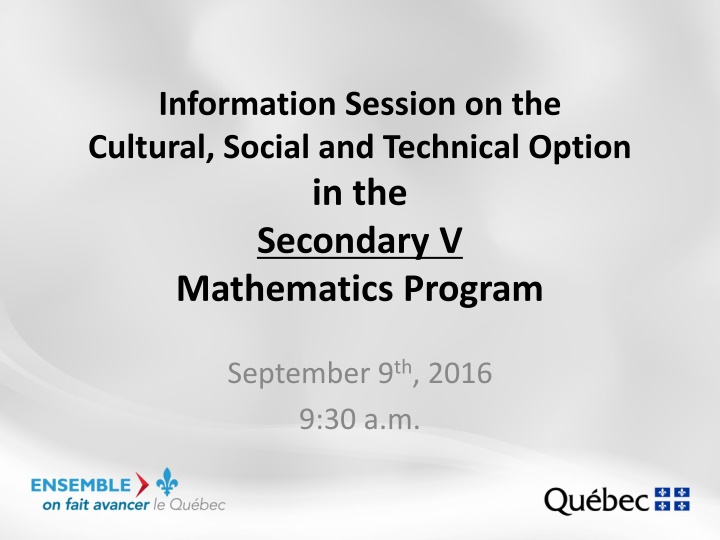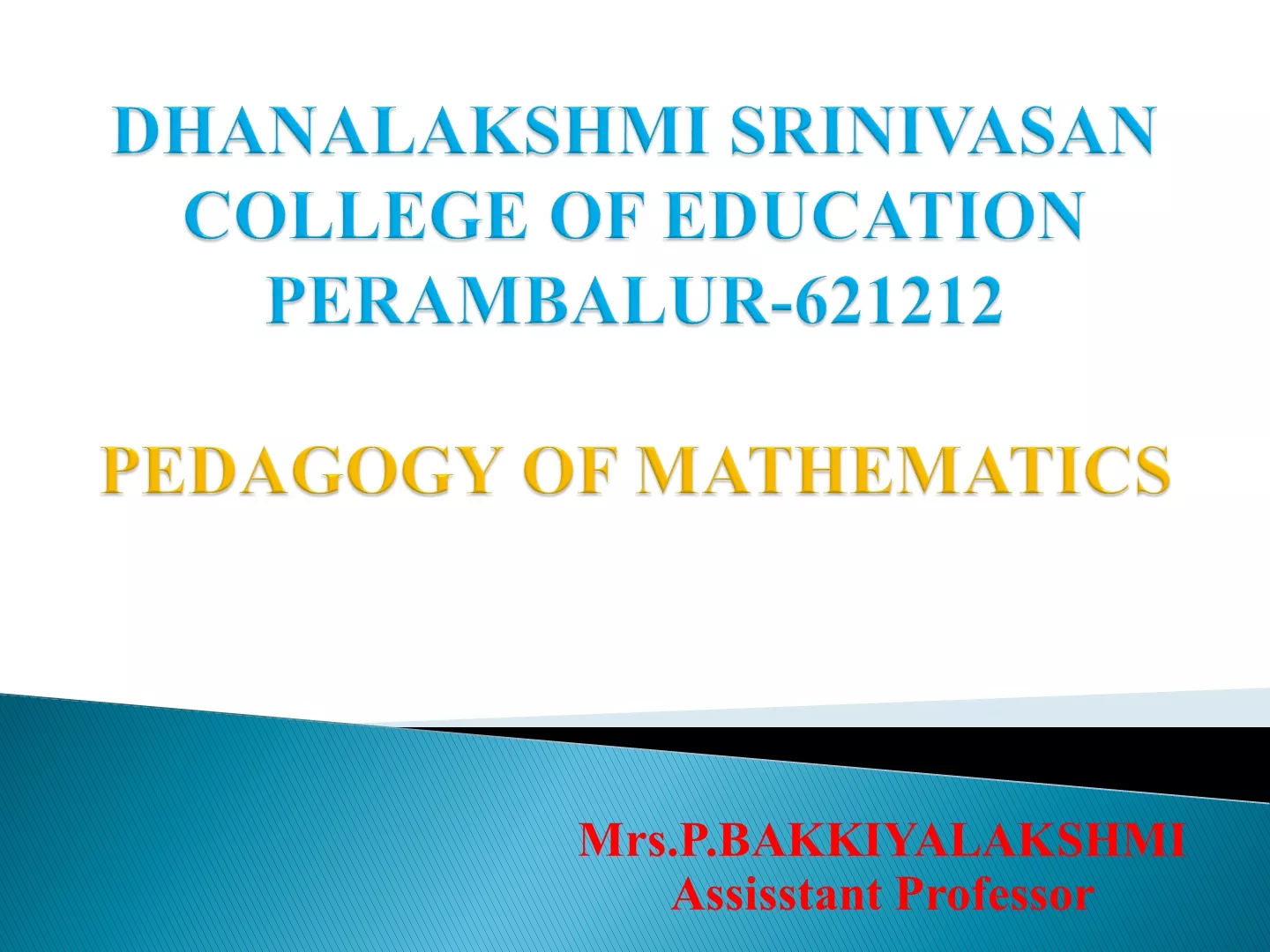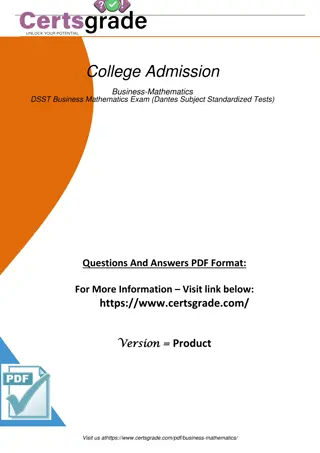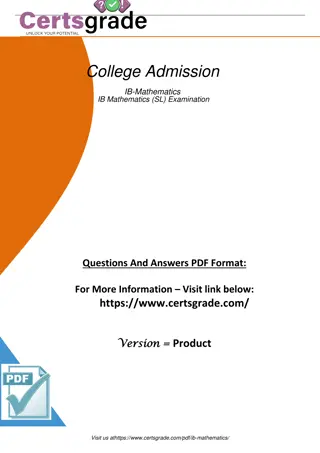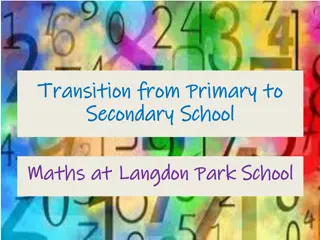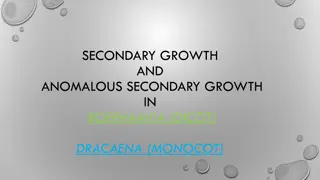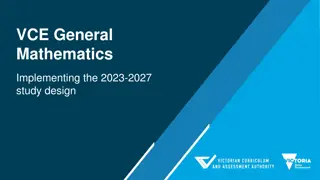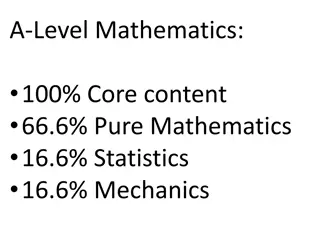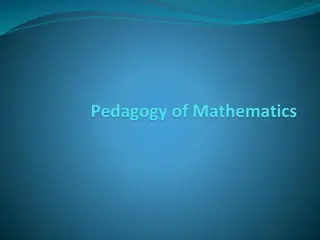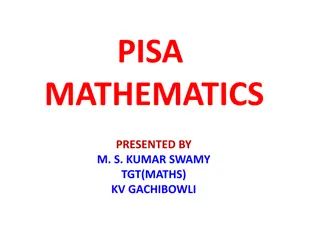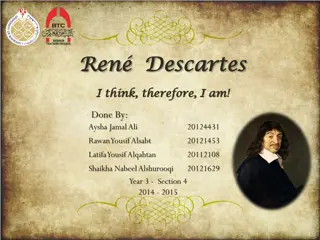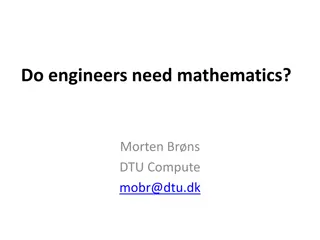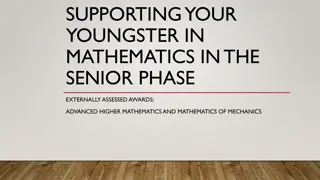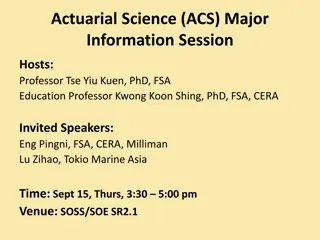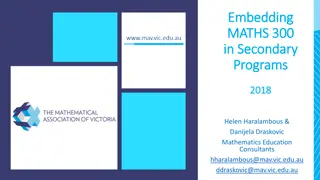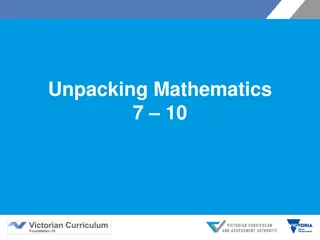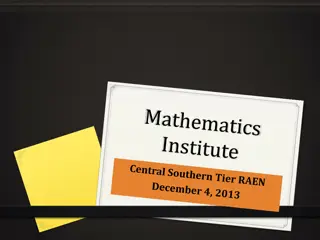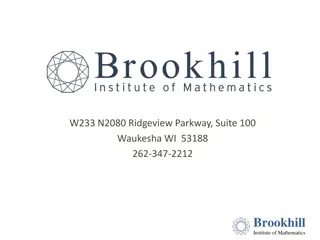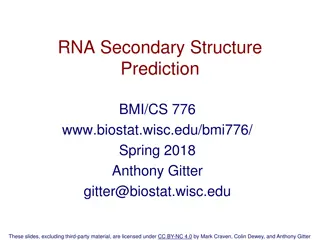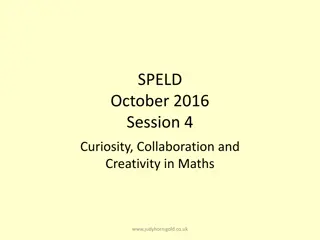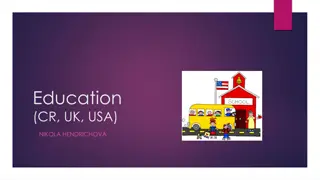Information Session on Secondary V Mathematics Program
Providing an overview of the Cultural, Social, and Technical (CST) option in the Secondary V Mathematics Program, this session covers objectives, context, objectives of the meeting, goals of the update, and points to consider. It discusses the process leading to the update, the balance between Secondary IV and Secondary V content, and access to technical training programs. Participants can ask questions via the chat room and gain insights into the program's enhancements.
Download Presentation

Please find below an Image/Link to download the presentation.
The content on the website is provided AS IS for your information and personal use only. It may not be sold, licensed, or shared on other websites without obtaining consent from the author.If you encounter any issues during the download, it is possible that the publisher has removed the file from their server.
You are allowed to download the files provided on this website for personal or commercial use, subject to the condition that they are used lawfully. All files are the property of their respective owners.
The content on the website is provided AS IS for your information and personal use only. It may not be sold, licensed, or shared on other websites without obtaining consent from the author.
E N D
Presentation Transcript
Information Session on the Cultural, Social and Technical Option in the Secondary V Mathematics Program September 9th, 2016 9:30 a.m.
Instructions for the Presentation Questions or comments must be sent using the chat room on the left side of the screen. Questions must be sent to Leaders. The questions will be answered following the presentation. If you experience any connection problems and briefly leave the platform, you can access it again by clicking on the link in the e-invite.
Overview of the Presentation 1. Objectives 2. Context 3. Presentation of the updated version of the CST option 4. Conclusion 5. Feedback 6. Question period
Objectives of the Meeting To explain the updated version of the Secondary V Cultural, Social and Technical (CST) option To explain the process that led to the update To train ambassadors
Goals of the Update To strike a better balance between the content covered in Secondary IV and in Secondary V To provide students in the CST option with access to more college-level technical training programs
Points to Consider The updated Secondary IV curriculum came into effect in 2015-2016. The update involved moving content from Secondary IV to Secondary V. The updated Secondary V curriculum will come into effect in 2016-2017.
Points to Consider Secondary V CST gives students access to only two more technical training programs than Secondary IV CST. The Secondary V CST option is considered to be easy.
Working Together With the Colleges The Direction des programmes de formation technique carried out the initial phase of work aimed at updating the minimum admission requirements. Goals: To validate the mathematics requirements To provide students with access to more technical training programs
Those Consulted Teachers of the CST option in Secondary IV and V Mathematics curriculum development specialists Coordinators of technical training programs and teachers at the college level Unions Minist re de l ducation et de l'Enseignement sup rieur (Direction de la formation professionnelle, Direction de l ducation des adultes et de l action communautaire, Direction des programmes de formation technique, Direction de l enseignement coll gial)
Overview of the Update CONTENT MOVED FROM SECONDARY IV TO SECONDARY V ADDITIONS CONTENT REMOVED In Geometry, all the content related to geometric transformations in the Cartesian plane All the content related to Probability The cosine law in Geometry In Arithmetic, the content related to the manipulation of numerical expressions involving powers and logarithms as well as concepts related to financial mathematics The content related to first-degree inequalities in two variables in Arithmetic and Algebra as well as half-planes in Analytic Geometry Made optional comprehensive activity for integrating mathematical learning
Content Moved From Secondary IV to Secondary V 1. All the content related to Probability Types of probability (experimental, theoretical, subjective) Concept of odds (for or against) Mathematical expectation Fair situation 2. The content related to first-degree inequalities in two variables in Arithmetic and Algebra as well as half-planes in Analytic Geometry
Addition: Cosine Law The cosine law in Geometry: Provides an opportunity to apply the trigonometric concepts taught in Secondary IV Does not take much time to teach May give the opportunity to students to be eligible for admission to at least eight more college-level technical training programs N.B.: Teach the cosine law in conjunction with equivalent figures and solids in Geometry.
Addition: Powers and Logarithms In Arithmetic, the content related to the manipulation of numerical expressions containing powers and logarithms (definition and change of base) Provides an opportunity to apply the exponential function taught in Secondary IV May give the opportunity to students to be eligible to at least 16 more college-level technical training programs
Addition: Powers and Logarithms The following equivalences will be covered: ? = ?? ????? =????? ????? = ? ????? N.B.: The properties of logarithms and logarithmic functions will not be covered.
Addition: Powers and Logarithms Students can now accurately solve 3 = 2? log23 = ? (definition) ? =log 3 log 2(change of base) Base 10 will be most often used. In Secondary IV, students used an approximate method to solve this type of equation.
Addition: Powers and Logarithms Have students work with various situations. Example: The population of a small village that now has 1200 residents is decreasing by 1% per year. In how many years will the population drop below 1000 residents? Students determine the rule: ? = 1200 1 0.01? where n represents the number of years elapsed. They then solve the equation: 1000 = 1200 0.99?
Addition: Powers and Logarithms ? = ?? log?? = ? Equivalences log?? log?? log?? = Students are now able to solve an equation like 2?= 15 Solving equations in various contexts Solving Equations Vocabulary Solving financial problems (compounding, discounting, depreciation, inflation, etc.) Financial Mathematics
Addition: Financial Mathematics The concepts pertaining to financial mathematics and the related vocabulary : Provides an opportunity to apply the concepts related to exponential functions learned in Secondary IV Consistent with the spirit of the CST option Promotes the use of software and spreadsheet programs
Addition: Financial Mathematics Concepts related to financial mathematics: Simple interest Compound interest Compounding Cn= C01 + in Discounting n: interest period i: interest rate Cn: future value C0: current value ?? C0= Cn1 + i nor ?0= (1+?)?
Addition: Financial Mathematics Example of a financial problem: Mary invests $1000 at an annual compound interest rate of 3%. In how many years will her investment double in value? Students determine the rule: ? = 1000 1 + 0.03? where n represents the number of years elapsed. They then solve the equation: 2000 = 1000 1.03?
Addition: Financial Mathematics Have students work with various situations: value of a good that increases or decreases (depreciation), value of a debt, price of certain goods depending on the inflation rate, etc. Example: It is estimated that a new car loses 15% of its value every year. In how many years will a car bought for $20 000 be worth $8000? Students determine the rule: V = 20 000 1 0.15? where n represents the number of years elapsed. They then solve the equation: 8 000 = 20 000 0.85?
Removed: Geometric Transformations in Geometry, all the content related to geometric transformations in the Cartesian plane
Made Optional: Comprehensive Activity The comprehensive activity for integrating mathematical learning will be optional. May provide more time that can be used for other topics
Next Steps The minimum requirements for admission to college must be approved by the Minister responsible for Higher Education.
Domaine MST Site Go to : domaine.recitmst.qc.ca Click on Math matique tab Click on English Documents tab To access the training documents: Password: ****** For documents published up to 2010: Username: ********
5. FEEDBACK Snapshot survey on the VIA platform Electronic two-way feedback form the e-questionnaire must be returned today or as soon as possible Thank you for your comments!
Ministre de lducation, et de l'Enseignement sup rieur Direction de la formation g n rale des jeunes Mathematics Program Team Mariannik Toutant Coordinator, Mathematics Curriculums mariannik.toutant@education.gouv.qc.ca Nathalie Cr te Collaborator, Elementary-Level nathalie.crete@education.gouv.qc.ca Val rie Lebel Collaborator and webmaster for Domaine MST website valerie.lebel@education.gouv.qc.ca Mireille Gosselin Collaborator, Secondary-Level mireille.gosselin@education.gouv.qc.ca
